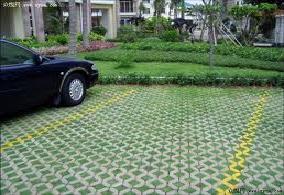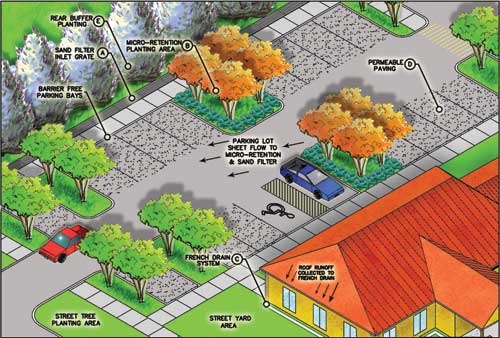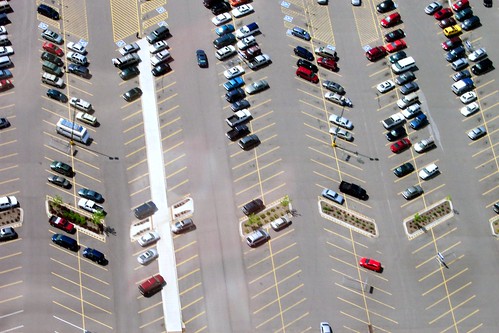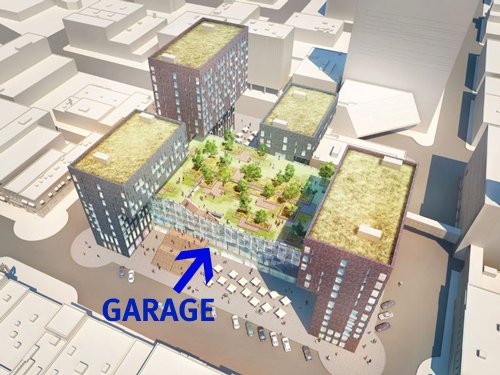How and why we should green parking facilities

Posted March 29, 2012 at 1:27PM
In 2007, New York City began to soften the harsh environmental effects of its many parking lots by adopting an innovative amendment to its zoning code. My New York colleague Larry Levine reports that for most new and expanded lots it requires the use of planted areas both around the perimeter and inside the facility, with the paved areas graded so as to drain stormwater into the planted areas (and away from overburdened sewers). It also requires shade trees, bicycle parking, and the screening of trash receptacles. The city’s planning office says that the changes are intended to reduce the urban heat island effect, achieve cleaner air quality through the planting of shade trees, promote efficient management of stormwater runoff, and to improve visual aesthetics.
These are important changes for the environment, given what a huge part of our land area is given over to parking. (The portion ceded to parking way is too large, actually, and I’ll get to that in a minute.) In the case of the New York ordinance, Larry reports that the measure led to other, broader reforms for green infrastructure under New York’s rightly celebrated PlaNYC. (See, for example, what the city has done for complete, green streets.)
Beyond impacts on the natural environment, parking facilities also have a huge impact on the community environment. For example, a couple of years ago I posted a series of photos and a narrative illustrating the unfortunate (and, perversely, sometimes required) practice of placing parking lots in front of businesses, civic institutions and apartment/condo buildings, separating the buildings from sidewalks and streets. This creates longer and more dangerous walking routes for pedestrians as well as a visual incoherence that is, in my opinion, inherently anti-community. It also makes public transit less attractive and viable, since the transit user’s journey from the bus stop to the store or apartment must take place through a sometimes-large and dicey parking lot instead of simply to a door on a sidewalk.
As I wrote then, citing my friend Chuck Marohn, one very helpful design solution is to put the parking in the rear. You can put just as much parking in back as in front, but the result when you do is far more inviting to pedestrians and more conducive to having a “there” in your community, to paraphrase Gertrude Stein. Some communities have even “wrapped” parking garages with housing in order to preserve a people-friendly streetscape.
 Now, in many circles that I travel in, people would frankly rather just eliminate parking or greatly reduce it, rather than think about softening its impact. Minimum parking requirements, common in communities for new multi-family housing and office construction, are especially hated. I get that. The most articulate of the criticisms of minimum parking requirements that I have read recently is by Tom Vanderbilt, author of the fascinating book Traffic. Vanderbilt quotes planning professor Donald Shoup:
Now, in many circles that I travel in, people would frankly rather just eliminate parking or greatly reduce it, rather than think about softening its impact. Minimum parking requirements, common in communities for new multi-family housing and office construction, are especially hated. I get that. The most articulate of the criticisms of minimum parking requirements that I have read recently is by Tom Vanderbilt, author of the fascinating book Traffic. Vanderbilt quotes planning professor Donald Shoup:
"[Parking minimums] distort transportation choices toward cars, and thus increase traffic congestion, air pollution, and energy consumption. They reduce land values and tax revenues. They damage the economy and degrade the environment. They debase architecture and urban design. They burden enterprise and prevent the reuse of older buildings. And they increase the prices for everything except parking."
Vanderbilt goes on to cite changes to minimum parking laws in a number of cities, including Columbus, which found that parking lots at its shopping malls were half-empty and reduced its minimum as a result. Washington, DC has eliminated minimums for certain retail establishments in high-density areas.
The critics of parking definitely have a point. But expanding on that is for another day.
In the meantime, Eran Ben-Joseph, writing in the New York Times, reminds us that, although parking lots are “an ugly reminder of the costs of our automobile-oriented society,” they are nonetheless very much with us, and having a major impact on our communities that can and should be transformed:
“Parking lots are, in fact, much more than spots to temporarily store cars: they are public spaces that have major impacts on the design of our cities and suburbs, on the natural environment and on the rhythms of daily life. We need to redefine what we mean by ‘parking lot’ to include something
that not only allows a driver to park his car, but also offers a variety of other public uses, mitigates its effect on the environment and gives greater consideration to aesthetics and architectural context.
“It’s estimated that there are three nonresidential parking spaces for every car in the United States. That adds up to almost 800 million parking spaces, covering about 4,360 square miles — an area larger than Puerto Rico. In some cities, like Orlando and Los Angeles, parking lots are estimated to cover at least one-third of the land area, making them one of the most salient landscape features of the built world.”
Ben-Joseph argues that parking lots constitute perhaps our most regularly used outdoor space and are, even if privately owned, public in the way most of them are experienced. Indeed, sadly, “a parking lot is the first part of a space you visit or live next to. It is typically the gateway through which dwellers, customers, visitors or employees pass before they enter a building.”
So, what to do? Ben-Joseph’s main point is simply that we need to take such an important part of our environment more seriously and design it more thoughtfully. He clearly favors the kind of green infrastructure now required in New York and goes further to suggest, for example, placing solar panels over parking lots to generate clean power at the same time as providing shade to create a cooler surface. Out the window of a hotel in Victoria, British Columbia, I saw a parking shed covered with a green roof. It’s a start.
(I am not nearly as enamored, though, of a “stunning” parking lot that Ben-Joseph praises in his article. Built as part of the Dia art museum, the lot to me looks much like a pretty version of unwalkable suburban sprawl. I suppose it absorbs stormwater - it looks like it does - but I don't see it as praiseworthy from a broader environmental point of view.)
In 2008, the federal EPA published a Green Parking Lot Resource Guide, full of good ideas about how to improve these facilities. The guide covers a solid menu of best practices, covering these subjects:
- Stormwater management
- Surface material selection
- Parking requirements
- Parking placement
- Natural landscaping
- Irrigation
Casey Trees, the nonprofit that is helping re-green DC, also has a nice, short guide to improving parking facilities emphasizing, naturally, trees. San Mateo County, California, has a 167-page Sustainable Green Streets and Parking Lots Design Guidebook that has been praised by the American Society of Landscape Architects.
The resources, covering both policy and design, are there and appear to be good ones. While I understand the ambivalence (or, in some cases, hostility) of some commenters toward parking, I agree with Ben-Joseph that it is an important aspect of our communities that could be handled much, much better. Lots of us drive for various understandable reasons - every community is not going to be New York or San Francisco, to say nothing of Copenhagen - and, when we do, we should be able to park in a place that is not only convenient but also greener, more aesthetically pleasing, and people-friendly.
Move your cursor over the images for credit information.
Please also visit NRDC’s sustainable communities video channel.




